You may not recognize the name Soichi Sunami. But, if you’re remotely interested in modern dance history, you’ve seen his iconic photographs of Martha Graham, Agnes de Mille, Ted Shawn, Ruth St. Denis and other pioneering choreographers in their 1920s heyday.
That stunning image of Graham painfully bent in her classic solo, Lamentation?
Sunami captured her at the debut in January 1930.
That striking 1928 profile of de Mille, her cascading hair half-obscuring her face as she turns from the camera?
That’s Sunami, too.
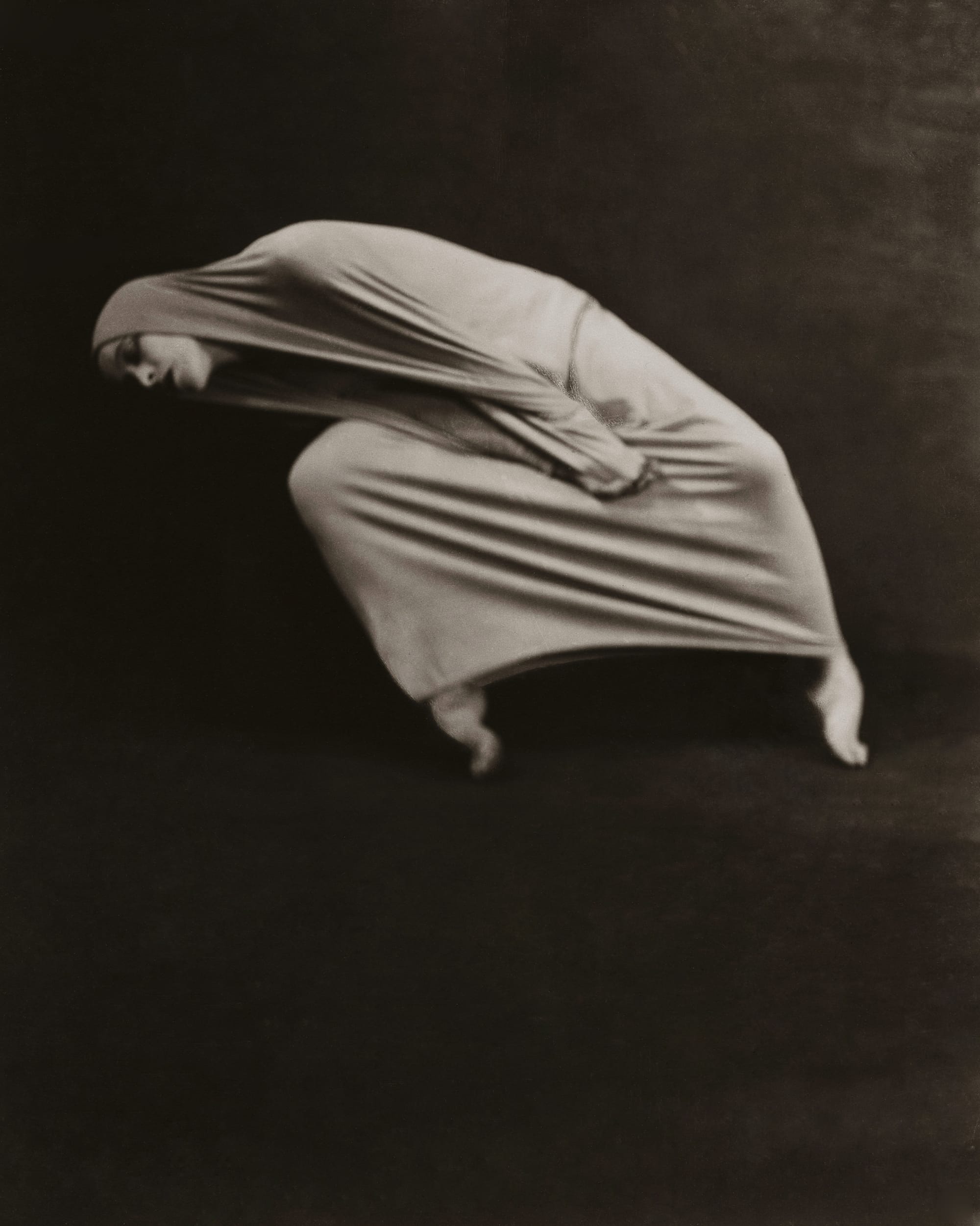
The Cascadia Art Museum’s latest show, Invocation of Beauty: The Life and Photography of Soichi Sunami, offers a broad survey of the Japan-born photographer’s career. The Edmonds museum highlights his formative years in Seattle and then follows through with work from his decades in New York, where he moved in 1922 in his late-’30s.

Sunami, who died in 1971 at age 86, immigrated in 1907 to Seattle and became deeply involved in the “pictorialist” experiments of the Seattle Camera Club, which promoted the notion that photography could be a fine art rather than a mere record of reality. For almost 40 years, Sunami was the go-to photographer for New York’s Museum of Modern Art, documenting its collection until his retirement in 1968.
Most of the work in Invocation of Beauty dates from the 1920s and 1930s, when Sunami was capturing cutting-edge developments in early modern dance. He also photographed productions by the New Negro Art Theater Dance Group, and his portrait subjects included painter Edward Hopper, diarist Anaïs Nin and a very young Gore Vidal.
But it’s the dance photography that dazzles and makes you ask: Why didn’t I know Sunami?
The better question is: Who is making sure I do?
That would be David F. Martin, whose mission since moving to Seattle in 1986 with his partner Dominic Zambito has been to uncover lost chapters in Pacific Northwest art history. He’s been the force behind the re-emergence of photographer Virna Haffer and painter Z. Vanessa Helder as significant local figures, who were honored with solo shows at the Tacoma Art Museum in 2011 and 2013, respectively. He also shed revealing light on the Seattle Camera Club with a 2011 group show, Shadows of a Fleeting World, at the Henry Art Gallery.
It wasn’t until the Cascadia Art Museum opened in 2015, however, that Martin had a free hand to champion artists he felt hadn’t received their due. Martin is CAM’s chief curator. Invocation of Beauty, which comes accompanied by a handsome, informative exhibit catalog, is his latest passion project.
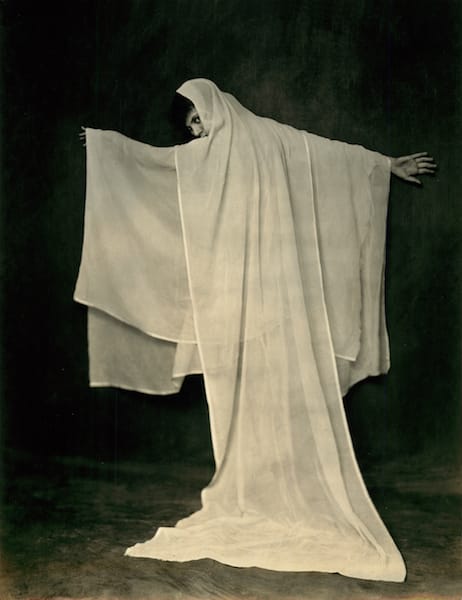
Martin became interested in Sunami’s work 25 years ago, when a friend introduced him to Sunami’s widow, Suyeko Sunami. She showed Martin the family’s collection of her husband’s works. Martin strived for years to get a museum interested in doing a Sunami show.
“When Cascadia Art Museum became a reality,” Martin wrote in a recent email, “the founder, Lindsey Echelbarger, basically told me to produce exhibitions and books that would promote the region’s cultural history. With a venue secured, I went directly to work selecting the photographs to best represent Mr. Sunami’s exquisite talent.”
Most of Sunami’s career unfolded in New York and his Seattle connection, Martin reminds us, hasn’t been much noted.
“Had it not been for the advanced photographic culture of Seattle in the early 20th century, Sunami would have never been able to create one of the most important bodies of work in the field of dance photography ever produced in the U.S.”
Below you’ll find Martin’s comments on selected photographs from the exhibit.
Tamiris in a pose from Subconscious for a program of Dance Moods at the Little Theatre, Sunday, Oct. 9, 1927
“Tamiris — the stage name for Helen Becker (1905-1966) — was a successful American choreographer, modern dancer and teacher. Sunami’s images of her are fascinating and invite study. One work in particular shows her in a pose from Subconscious for a program of Dance Moods at New York’s Little Theatre in 1927. Tamiris shocked the audience by dancing nude in a segment of the production. She danced for three seasons with the Metropolitan Opera Ballet and the Bracale Opera Company before studying briefly with Michel Fokine. In 1927, she made her premiere as a solo modern dancer and two years later formed her own school and company. Much of her work dealt with social issues like racism, war and labor inequity. She is best known for her suite of dances called Negro Spirituals, which was created between 1928 and 1942. This was a production of the Federal Dance Project of the Works Progress Administration (WPA), which explored the problems facing African Americans. It was the first time that federal funds were utilized in a creation of American dance.”
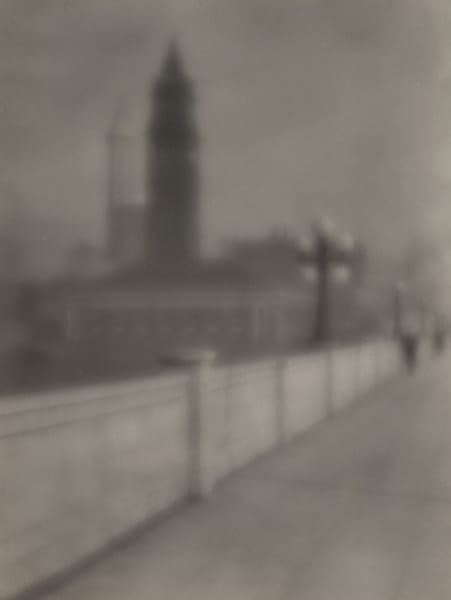
“October Mist” (circa 1920), gelatin silver print
“I had to start with his beautiful Northwest landscapes for which he first gained local recognition. These pictorialist images are poetic and atmospheric with a sense of light that is unique to this region. His ‘October Mist’ was an award-winning early work depicting an Impressionistic view of Seattle’s Smith Tower and King Street Station enveloped in layers of misty tonal values.”
Self-portrait with sculpture (circa 1920), gelatin silver print
“Sunami’s employment with the legendary Ella McBride (1862-1965) and her Seattle studio was pivotal to his success. Mrs. Sunami once told me that her husband felt he owed his career to McBride and her business partner, Wayne Albee (1882-1937), who was then the leading artistic photographer in the region. The two mentored Sunami as a young man and encouraged his career. Sunami’s many early self-portraits show that he preferred presenting himself as a painter or sculptor rather than posing with a camera. In a circa-1920 self-portrait taken in the McBride Studio, he holds one of his plaster relief sculptures created while working with a young Japanese painter and sculptor named Ryumon Yasuda (1891–1965), who was visiting Seattle.”
Martha Graham in Lamentation (1930), gelatin silver print with texture screen
“Because McBride’s studio was retained by Nellie Cornish to document performances at her progressive school (Cornish College of the Arts), McBride and her fellow photographers were exposed to some of the world’s greatest dancers who were performing locally. Albee, McBride and their colleague, Frank Asakichi Kunishige (1878-1960), photographed Ruth St. Denis, Martha Graham, Ted Shawn, Doris Humphrey and many others. Sunami assisted the more experienced Albee and Kunishige while sometimes creating images on his own. When Sunami moved to New York in 1922, he used his Seattle connections to reconnect with major dance figures, all of whom he met at the McBride Studio. His multiyear collaboration with Martha Graham produced some of the finest images of the iconic dancer. When Mrs. Sunami first showed me the image of Martha Graham in her dance Lamentation of 1930, I was awestruck at the pose and couldn't imagine how Graham was able to support her body weight on her bent feet. Mrs. Sunami laughed at me and said, ‘David, she is sitting on a box and Sunami burned it out in the studio.’ Although my naïve statement first embarrassed me, I realized the true art of Sunami’s darkroom techniques.”
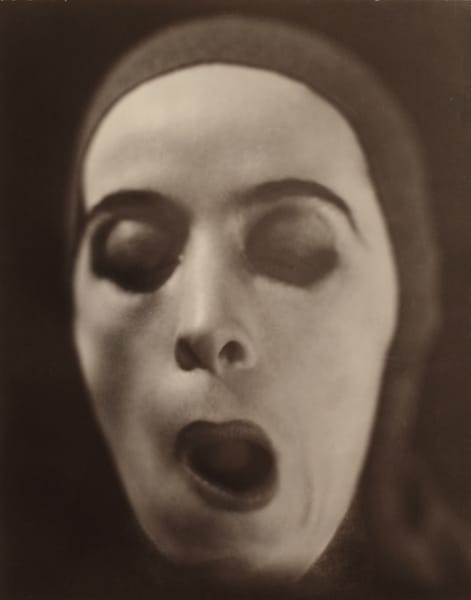
Martha Graham in Lamentation (1930), gelatin silver print
“Another image of Graham from Lamentation also intrigued me. It was a detail of her face in a gestural, masklike grimace. I soon learned of Sunami’s interest in Japanese and Native American ceremonial masks, and the odd portrait suddenly made sense.”
Title unknown (circa 1930), gelatin silver print
“Sunami’s Japanese heritage also played a part in his landscapes, as well as portraiture. Another important image depicts dancer Edna Guy (1907-1982) in an unusual perspective, gazing up and looking away from the viewer with the focus on her featherlike hair and almond-shaped eyes in a gesture that appears to be inspired by the Mie pose of Kabuki Theater. Ms. Guy, one of the few African-American dancers of that era, is only beginning to be rediscovered, and Sunami’s photos of her are some of the only extant images to document her appearance.”
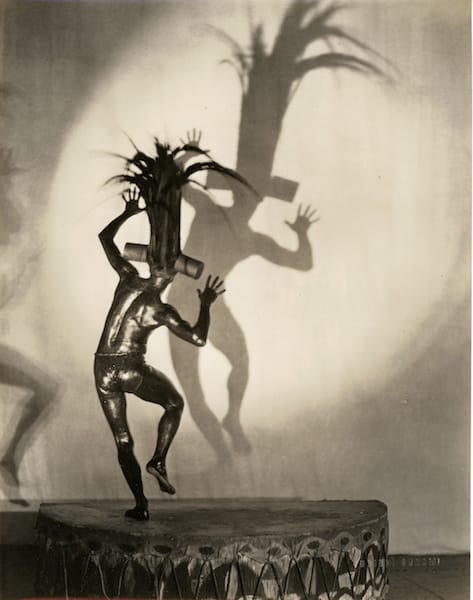
Jacques Cartier performing his “Voodoo Dance” (1927), gelatin silver print
“European dancer Jacques Cartier (1907-2001), who was white, donned dark makeup and performed this dance in several Broadway venues to great acclaim in the 1920s. Cartier’s striking, muscled figure is framed against his large, looming shadow that was projected behind him. Cartier was in no way making light of Black culture. He was known for his interpretations of ethnic dances and would often appear in makeup as various races in productions on Broadway and other New York venues. For a while, he was active in the Ziegfeld Follies. He studied Native American and Japanese dances and incorporated these into his modern choreography. After a successful career in New York, he moved to Santa Fe where he became a dance and drama instructor. In the 1930s, Cartier created ‘The Fire Dance’ for Santa Fe’s Zozobra Festival.”
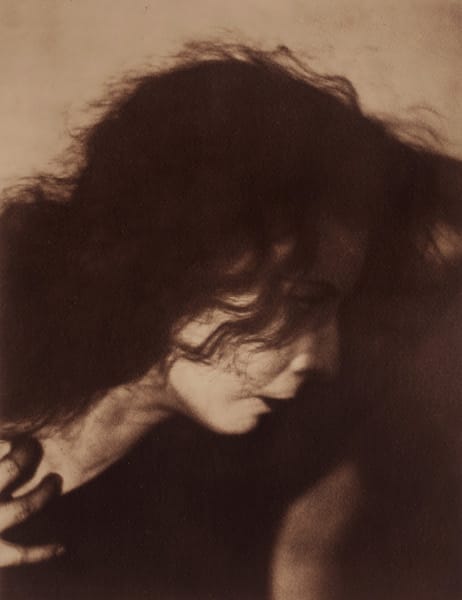
Agnes de Mille (circa 1928), gelatin silver print
“Another stunning image depicts the dancer Agnes de Mille (1905–1993), who had success in classical and modern dance, as well as on Broadway and in film choreography. De Mille posed for Sunami in many scenarios, but one in particular transcends their usual dance focus. Rather than concentrating on gesture, Sunami utilized de Mille’s distinctive profile in a purely artistic and abstract statement. De Mille’s eyes are obscured as she is aligned in a diagonal composition giving the suggestion of a Pre-Raphaelite muse in meditation. Her wild and unruly hair frames an eerie pin spot of light throwing a dark shadow to contrast with her white skin. The mystery is compounded by the cropping of her fingers clutching clawlike at her throat.”
Doris Humphrey and company in Life of the Bee (1929), gelatin silver print
“While I was going through the Sunami collection, I noticed a series of incredible images depicting Doris Humphrey’s 1929 production of Life of the Bee, which was inspired by the 1901 Maurice Maeterlinck publication of the same name. The original production had no musical accompaniment. The dancers performed to the rhythm of people humming offstage. This innovative dance illustrates Sunami’s ability to convey the essence of the dancer’s gestures through a still photograph in an art form known for movement and motion. The kinetic ‘swarm’ behind Humphrey is not static. Its members subjugate their individuality to her dominance in a wry social commentary on human behavior.”
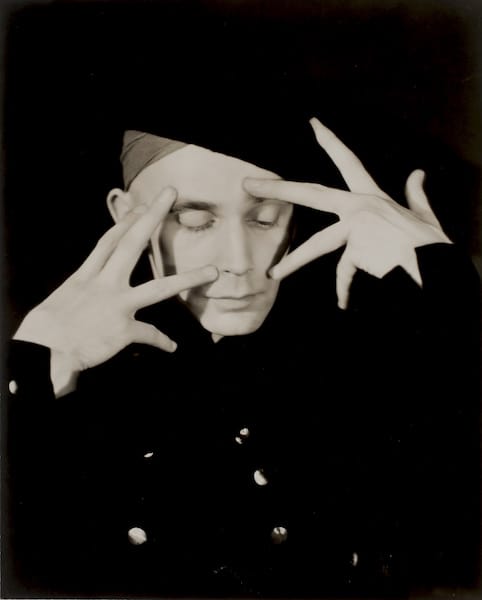
Harald Kreutzberg (circa 1933), gelatin silver print
“Another once famous dancer whose work is just beginning to be rediscovered was Harald Kreutzberg (1902-1968), an important figure in German modern dance who performed in the U.S. for several decades. His choreography combined drama and humor with an emphasis on improvisation. Kreutzberg’s unique physical appearance and flair for drama provided fertile inspiration for Sunami, whose work mostly concentrated on women dancers. Sunami’s four studies of Kreutzberg are among the standouts in his oeuvre. By coincidence and luck, the evening after the opening of the Sunami exhibition at CAM, the University of Washington’s Chamber Dance Company performed a series of rare dances that included Kreutzberg’s Dances Before God.” [NOTE: Invocation of Beauty includes a film-clip montage in which you can see Kreutzberg himself in action, along with many other dancers featured in the show.]



